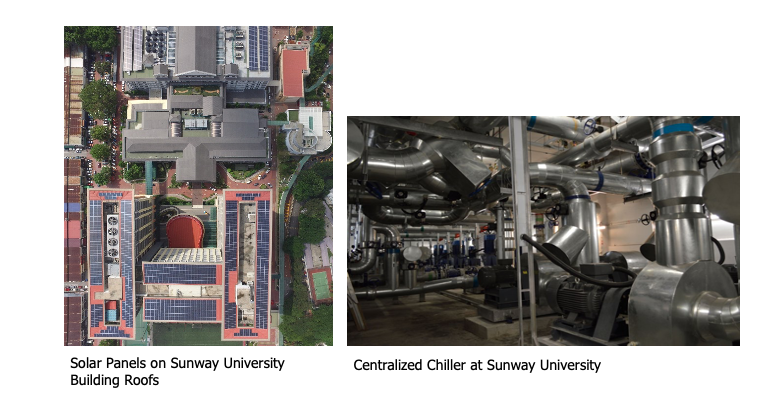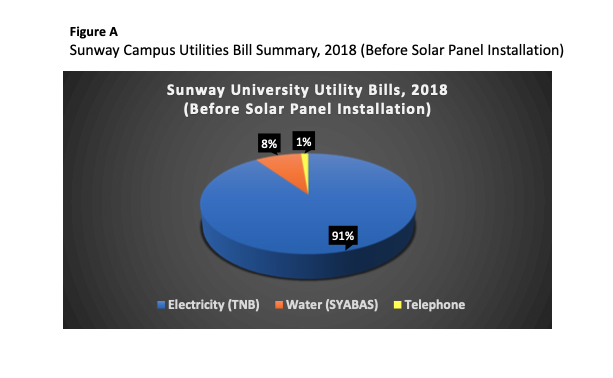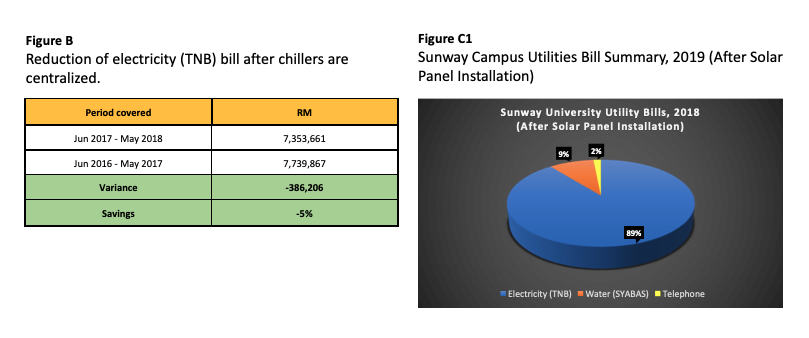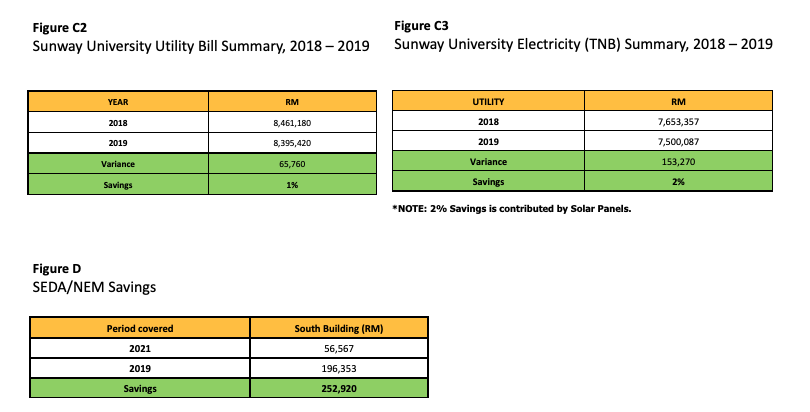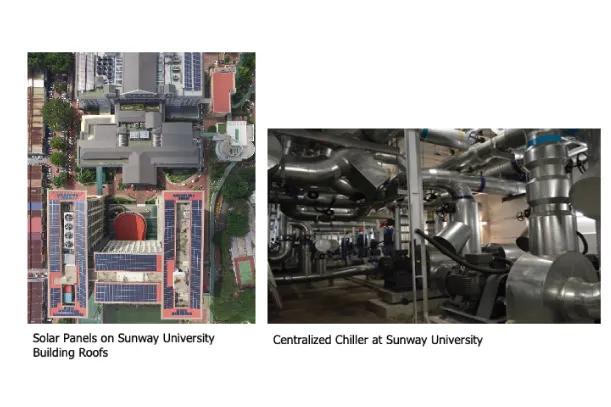Energy Efficiency & Carbon Footprint Reduction 2016 – 2020 Projects
Project 1 in 2016 – Centralized Chill Water
Sunway University’s campus consists of both old and new buildings. In 2016, a study conducted on the usage of electricity showed that approximately 70% of electricity was consumed by the chillers to cool the buildings. The chiller operations in the older buildings whose chillers were more than 25 years old, contributed towards a large proportion of the energy consumption. As such, an initiative was undertaken to consolidate and centralize the chiller operations by using the newer University building chillers (which were more efficient and had extra capacity) to supply to the older buildings on campus. The gains were visible during the year as consumption reduced by 5%. (Refer to Figure B in the Appendix)
Project 2 in 2018 – Solar Panels
At the same time, The Ministry of Energy, Science, Technology, Environment and Climate Change (MESTECC) has set a target to achieve 20% Renewable Energy in national renewable power mix by 2025 while ensuring price affordability and system stability. Therefore, it is essential that the campus adopt an energy policy to promote the conservation of energy. This will result in savings that can be invested in University infrastructure upgrades in addition to conserving the natural resources. Although energy conservation is the focus of this policy, comfortable work and study conditions must also be achieved.
In 2018, the University worked on the installation of solar panels on the roof tops of two main university buildings to harvest solar power that currently powers up an older building. The oldest building on the campus was chosen to be the solar powered building because the electricity tariff per kilowatt was the highest @RM0.509 per kilowatt hour; compared to the newer buildings, where the tarrif was only RM0.365 per kilowatt hour. Having installed the solar panels in 2018, the savings made were reflected in the 2019 utility bill. There was a 2% reduction on the total electricity consumption. (Refer to Figure C1, C2 & C3 in the Appendix)
A 630.72kWp solar capacity system was installed and generating 672,000kWh (33% of South Building Consumption) clean energy per year equivalent to greenhouse gases (GHG) emission reduction approximately 393.12 tC02 while avoiding the fossil energy 0.143 ktoe. The new Net Energy-Metering (NEM) mechanism has been improved by adopting the true net energy metering concept, allowing excess solar Photovoltaic generated energy to be exported on a one-on-one offset basis which act as an encouragement for University to invest in this solar project while reducing of GHG and other pollutants emissions.
Sunway University focuses on the development of the Solar Photovoltaic system for the modern lifestyle, based on integrating innovation with sustainable consumption and environmental practices, aligned with the University policy.
Solar system supports green energy production and exporting excess energy into the grid via NEM scheme. It consists of PV Rooftop installations on various structures including Energy Monitoring system equipped with Solarlog; an online portal which offers comprehensive reporting options in the form of graphs and tables. The Solarlog provides a dashboard with a feature displays all important information for a plant such as yields, C02 savings, plant performance and fault identification. This Solarlog monitors and gathers all the data of all Sunway Solar system all over the Malaysia. Currently, Sunway have six solar systems all over the Malaysia. This solar system also acts as educational platform for students and R&D platform for researchers.
Project 3 in 2020 – Selling Excess Energy Back to TNB Grid
Through the success of the solar panel project, the University realised it was able to harvest excess energy compared to utilisation and so in 2020, the excess energy harvested was sold to TNB (Tenaga Nasional Berhad) also known as the National Electricity Board grid via SEDA (Sustainable Energy Development Authority) / NEM (Net Energy Metering) arrangements. These sales amount has seen a further reduction in the bills by 71% since 2019. (Refer to Figure D in the Appendix)
